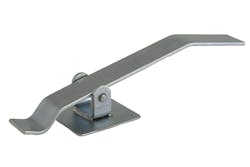At one time the installation of lock hardware was labor intensive. Each lock company had their own individual lock case dimensions. Either new installations or hardware replacement were cut and fit procedures. Use of odd dimensions may have differentiated one manufacturer from another but this caused a problem later when a broken or worn lock needed replacement. One glance through a key blank catalog shows how many once popular lock company names have disappeared from the market. Remaining lock companies often had no exact replacements available. The hardware industry finally responded by standardizing lock case dimensions. Normal cross bore and mortise lock case sizes taken for granted today are the result of this standardization.
Common lock dimensions eased every lock installation. A locksmith could approach every job knowing that new hardware would fit in place of existing old hardware. If old lock hardware was from pre-standardization times, a problem still existed. Several manufacturers responded by offering lock installation tools to re-bore lock mortises to new standardized dimensions. Installation tools could be clamped onto the door and guide the hole cutter to exacting dimensions.
As example, at one time Kwikset knob locks required a series of three small cross bore holes. Two holes were for retaining screws and one hole housed the central spindle. Kwikset later changed to a standard 2 1/8" cross bore. An installation tool made quick work of re-boring an old three-hole mortise to the new 2 1/8" standard cross bore size.
Key in knob locksets became the hardware of choice during the the last 50 years due to lower product costs compared to mortise locksets and to the ease of installation. One installation tool could be used regardless of the brand of lock being installed. This all changed in the mid-nineties with a government handicapped mandate for lever locks.
Lever lock housings tend to rotate in the cross bore under heavy usage or during attempted forced entry. The solution for some lock manufacturers was to install secondary retaining screws outside the diameter of the 2 1/8" cross bore. Installation tool manufacturers developed a group of new template forms which allowed locksmiths to drill precise holes for both the primary cross bore and for the added retaining screw locations. One template does not fit all. Locksmiths must stock a specific template for each lock manufacturer product to be installed.
Many electronic locks may also require special installation templates. While most electronic locks are designed to fit into a standard 2 1/8" cross bore, there are often additional holes required for connecting wires from exterior to interior locations and for retaining the keypad and lock body together. As with lever locks, each manufacturer has their own secondary hole locations and locksmiths must stock a specific template for each lock manufacturer product to be installed.
Mortise lock cases require a rectangular cutout into the edge of the door. Installation tool manufacturers have solved this problem with a jig which has a movable hole bore setting. Each hole is drilled to the required depth and the drill bit holder is then moved to a new vertical location. The result is a series of round, overlapping holes forming the mortise pocket. The same installation tool can be used with slightly larger drill bits to form the mortise lock face plate area. Rounded corners must be removed by hand with a chisel.
Aluminum doors have not been forgotten by installation tool manufacturers. Locksmiths are often called to install a secondary latch lock or an electric strike on aluminum doors. Cutouts on aluminum doors are usually made by a series of passes while removing thin layers of aluminum with each pass. If a lock or strike requires square corners this material must be manually removed.
Additional installation tools for locksmiths are available from many manufacturers and serve a wide variety of purposes. Major Manufacturing offers a range of tools, from our signature product, the Kee-Blok, to the multi-faceted Hardware Installation Tools (HIT) Series. Major’s newest products include the HIT-21 mortise cylinder locating and drill guide, the HIT-30L template guide holder for Adams Rite templates, the HIT-30L-100 template guide for Adams Rite A100 controls, the HIT-30L-125 template guide for Adams Rite 2190 dual force locks and the HIT-66-283 template for the Schlage LE mortise lock. More Info: www.majormfg.com.
Marray Enterprises, www.marray.com, offers a Dor-Cor tool for drilling raceways from the hinge edge to the lock edge for running wiring. A-1 Security, www.demanda1.com, offers the Kelly Clamp for holding a heavy magnetic lock in place during the installation process. HES (now part of ASSA ABLOY Electronic Security Hardware, has a template kit used for marking the cutout area for electric strike installations. Trine, www.trineonline.com, has a magnetized temporary strike plate which can be set in position on steel jambs for aligning mounting holes their surface-mounted electric strikes. Installation tool kits from original equipment manufacturers are available for installing their line of products.





